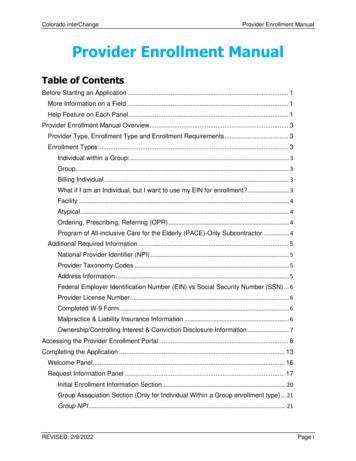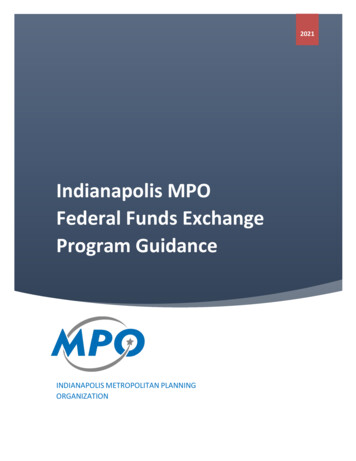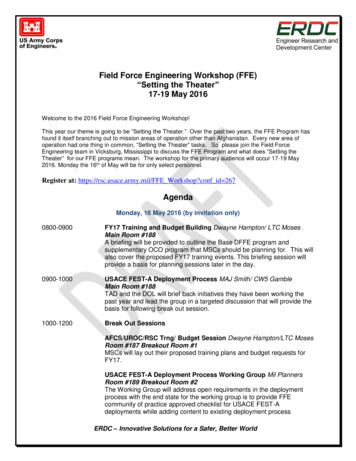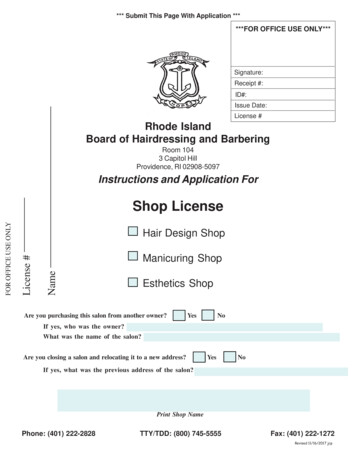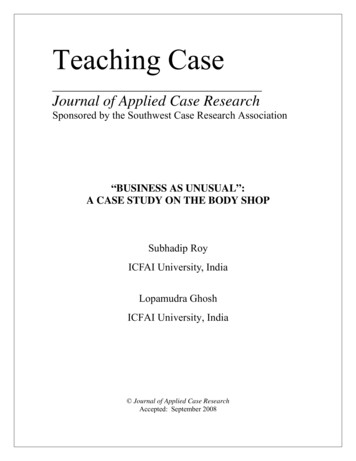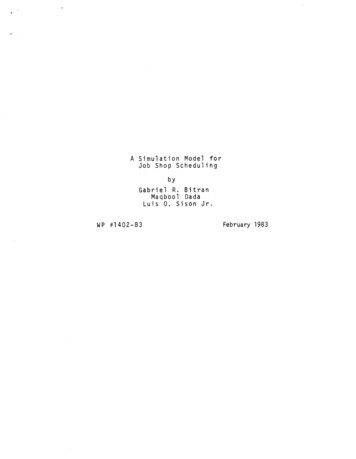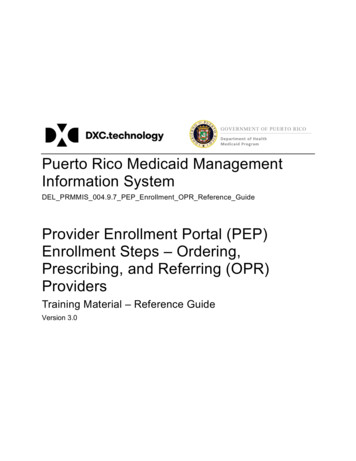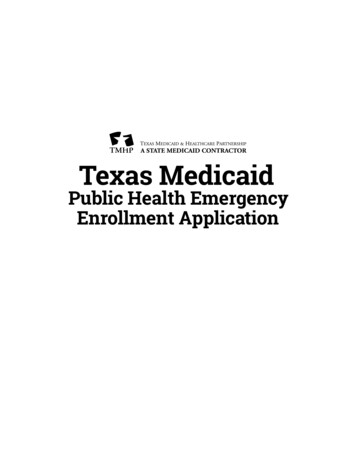
Transcription
FFE and FF-SHOP Enrollment ManualFederally-facilitated Exchange (FFE) and Federally-facilitated Small Business HealthOptions Program (FF-SHOP) Enrollment ManualThis manual is effective as of June 26, 2018. All enrollments made on or after June 26, 2018should be processed in accordance with the operational requirements set forth in this document.CMS intends to update this Manual regularly, and publish clarifying bulletins between updates.All previous versions of bulletins that have been incorporated into this version of the manualshould be considered superseded by this manual. If you have questions related to content postedwithin this manual, please email: EnrollmentGuidance@cms.hhs.gov.i
FFE and FF-SHOP Enrollment ManualTable of Contents1. Introduction and Scope . 11.1Background . 11.2Types of Exchanges . 11.3Purpose of Document . 21.4Acronyms and Definitions . 21.4.1Acronyms . 31.4.2Definitions. 51.5Additional Resources . 82. Enrollment in the Individual FFEs (Applicable To QHPs/QDPs) . 102.1Eligibility. 112.2Open Enrollment and Coverage Effective Dates . 112.3Enrollment Transactions . 122.3.1Initial Enrollment Transaction . 152.3.2Confirmation of the 834 Transaction in Individual Market FFE . 162.3.3Cancellations in the Individual Market FFE. 172.3.4Fraud Cancels Related to Approved Rescissions and Unauthorized Enrollments . 182.3.5Free Look Provisions in the Individual Market FFEs (Applicable To QHPs/QDPs) . 192.4Application and Enrollment Changes . 202.5Premium Payment in the Individual Market FFE . 222.5.1Payment of Premium by a Third Party . 242.6Redeterminations and Renewals in the Individual Market FFE (Annual OpenEnrollment) . 242.6.1Enrollment Transaction Types . 302.6.2CSR & APTCs Calculations on Passive Reenrollments . 412.6.3Plan Selection Changes During the OEP . 422.6.4Additional Files and Transactions to Support Issuers With Auto-Renewal . 422.6.4.1 Enrollee Switch File . 422.6.4.2 Passive Cancel Job. 432.6.4.3 Cancel Carry Forward Job . 432.6.4.4 BAR Progress Report . 442.6.5Effectuation at Reenrollment and Change in Circumstance . 442.6.6Life Changes During The Oep . 442.6.7Tobacco Rating at Time of Reenrollment . 452.6.8Medicare Enrollment And Nonrenewals . 453. Enrollment in the FF-SHOP. 473.1Eligibility. 473.2Minimum Participation Rates in the FF-SHOP. 49ii
FFE and FF-SHOP Enrollment Manual3.3Initial Enrollment and Coverage Effective Dates . 503.4Special Enrollment Periods . 503.5FF-SHOP Appeals . 503.6Plan Compare (See Plans and Prices) . 513.7Enrollment Into Shop QHPs and QDPs and Enrollment Changes . 513.8Premium Payment . 513.9Cancellations in the FF-SHOPs. 523.10 Terminations. 523.10.1 Group-Level Terminations in the FF-SHOPs . 523.10.2 Dependent Age-Offs in the FF-SHOPs. 523.11 Renewals in the FF-SHOPs . 523.12 FF-SHOP Required Notices . 534. Direct Enrollment (Applicable to the Individual Market FFEs, QHPs/QDPs) . 544.1Guidelines for Specific QI Scenarios . 554.1.1Applicant Not Eligible for QHP Enrollment . 554.1.2Applicant is Eligible for QHP Enrollment and APTCs/CSR. 554.1.3Applicant is Eligible for QHP Enrollment but Not for APTCs/CSR. 554.1.4Applicant is Eligible for Medicaid or CHIP . 564.1.5Households That Include QIs Eligible for Different Coverage Programs . 574.2Enrollment Groups . 574.3QHP Display Guidance . 584.3.1QHP Issuer DE Partners. 584.3.2Web-Broker DE Partners . 614.4Mandatory Attestations . 665 Special Enrollment Periods (Applicable to Individual Market FFEs, QHPs/QDPs) . 685.1Availability and Length of SEPs . 695.2SEP Triggering Events and Coverage Effective Dates . 695.3SEPs Accessed Outside of the Application Process. 855.4 Plan Display Errors . 856 Premiums (Applicable to Individual Market FFEs, QHPs/QDPs) . 896.1Effectuation of Prospective Coverage Under Regular Coverage Effective Dates andSpecial Effective Dates . 896.1.1Effectuation of Coverage With a Retroactive Effective Date Associated With anSEP That is Not Verified . 896.1.2 Effectuation of Coverage With A Retroactive Effective Date Associated With aVerified SEP . 916.1.3Payment for Reenrollments. 936.1.4Binder Payment Extensions Directed by the Exchange or State Authority . 936.2Premium Payment Threshold . 94iii
FFE and FF-SHOP Enrollment Manual6.3Terminations for Non-Payment of Premiums . 966.3.1. Issuer Option to Condition New Enrollment on Payment of Past Due Premium. 986.3.2Enrollment Transactions Received for a Subscriber Whose Coverage is BeingTerminated. 996.3.3 Additional Non-Payment Examples . 1026.4Grace Periods for Enrollees Receiving the Benefit of APTCs. 1066.4.1Claims Pended by an Issuer During a Three Consecutive Month Grace Period forEnrollees Receiving the Benefit of APTCs . 1066.4.2Grace Period Whose End Occurs After the End of the Annual Open EnrollmentPeriod. 1076.4.3Grace Periods Ending on or Before December 31 . 1096.4.4Termination Occurring During a Grace Period . 1106.4.5Involuntary Termination Due to a Citizenship/Immigration Status InconsistencyExpiration During a Grace Period . 1116.4.6Termination of APTCs During a Grace Period. 1116.4.7Premium Paid to an Issuer Through a Third-Party . 1126.5Over-Billed Premiums. 1126.6Under-Billed Premiums. 1126.6.1Collections and Grace Periods for Non-Payment of Under-Billed Premium . 1136.6.2Voluntary Termination of Coverage During Repayment of Under-BilledPremium . 1167 Terminations (Applicable to the Individual Market FFEs, SBEs-FP, QHPs/QDPs). 1187.1Enrollee Requested Terminations . 1187.2Termination of an Enrollee’s Coverage in the FFEs Due to Death . 1187.3Aging-Off Terminations . 1208 Reinstatements (Applicable To Individual Market FFEs, QHPs/QDPs) . 1218.1Reinstatements in the FFEs . 1219. Enrollment Data Alignment (Applicable to Individual Market FFEs, QHPs/QDPs) . 1249.1Inbound 834 (IC834) . 1269.2Enrollment Reconciliation & Pre-Audit Files . 1289.3Resolution of Enrollment and Payment Discrepancies (Disputes) . 1309.3.1Payment Disputes. 1319.3.2Enrollment Disputes . 1329.3.3HICS Direct Dispute Process: . 13410. Form 1095-A Generation And Corrections . 13610.1 Form 1095-A Initial Generation Process . 13610.2 How Issuers Should Answer Enrollee Questions About Form 1095-A . 14010.3 Form 1095-A Basics for Assisting QHP Enrollees . 14110.3.1 Form 1095-A Reprints and Corrections . 142iv
FFE and FF-SHOP Enrollment Manual10.3.2 Form 1095-A Corrections Process: Additional Information . 14310.4 Impact of Prior Year Appeals. 14411. QHP Coverage & Other Minimum Essential Coverage in the FFEs . 14611.1 Periodic Data Matching . 14711.2 Medicaid/CHIP Periodic Data Matching . 14711.3 Medicare Periodic Data Matching . 14811.4 Medicare Anti-Duplication . 14912. Addressing Individual-Reported Unauthorized Enrollments & Issuer-ReportedFraudulent Enrollments. 15012.1 Individual Complaints Alleging Unauthorized Enrollments . 15012.1.1 Operational Process for Cancelling Unauthorized Enrollments . 15112.2 Issuers’ Requests: Examples of Elements Demonstrating an Appropriate Rescission ofQHPs in the Exchanges . 15312.2.1 Reporting Fraudulent Enrollments . 15312.2.2 Bases for a Rescission . 15413. Effectuation of Eligibility Appeal Decisions and Related Enrollments in the FFEs . 15713.1 Impact of Appeals on Reconciliation . 16714. Health Insurance Casework System (HICS). 16915. Data Matching Issues (DMI) Monthly Processes . 17315.1 Data Matching Issues Outreach Schedule and Process . 17515.2 Late Submission of Documentation for Data Matching Issues . 176Appendix A – Sample Welcome Letter . 177Appendix B – Sample Non-Payment Notices . 180Appendix C – Sample Termination Letter . 186v
FFE and FF-SHOP Enrollment ManualList of ExhibitsExhibit 1 – Commonly Used Acronyms . 3Exhibit 2 – Additional Resources . 9Exhibit 3 – FFE Enrollment Process . 10Exhibit 4 – Coverage Effective Dates for the 2019 FFE OEP . 12Exhibit 5 – Retroactive Enrollment Reasons and Dates . 14Exhibit 6 – Retroactive Termination Reasons and Dates . 14Exhibit 7 – Retroactivity Examples . 15Exhibit 8 – Process for Reporting Changes . 20Exhibit 9 – Reportable Changes . 21Exhibit 10 – Passive reenrollment codes . 32Exhibit 11 – NPN Rules. 34Exhibit 12 – Reenrollment Transaction Illustration. 35Exhibit 13 – Multiple Transactions Illustrated for a Single Enrollment . 41Exhibit 14 – State FF-SHOP Minimum Participation Rates . 49Exhibit 15 – SEP Triggering Events and Coverage Effective Dates Summary . 72Exhibit 16 – SEP Effective Date Examples . 84Exhibit 17 - Processing Plan Display Error SEPs . 87Exhibit 18 - Resolving Plan Display Error SEPs . 88Exhibit 19 – Premium Payment Threshold Lifecycle . 95Exhibit 20 – Volume of Policy Updates Performed . 125Exhibit 21 - PPR-820 Payment Dispute Process . 131Exhibit 22 - Enrollment Dispute Process . 132Exhibit 23 - HICS Dispute Process . 134Exhibit 24 – Form 1095-A Generation Process Overview . 137Exhibit 25 – Anatomy of a Form 1095-A . 138vi.
FFE and FF-SHOP Enrollment Manual1. INTRODUCTION AND SCOPE1.1 BACKGROUNDThe Patient Protection and Affordable Care Act (Pub. L. 111–148) was enacted on March 23,2010. The Health Care and Education Reconciliation Act of 2010 (Pub. L. 111–152), whichamended and revised several provisions of the Patient Protection and Affordable Care Act, wasenacted on March 30, 2010. In this manual, the two laws are referred to collectively as thePatient Protection and Affordable Care Act (PPACA). The PPACA creates new competitiveprivate Health Insurance Exchanges that enable qualified individuals (QIs) to shop for, select,and enroll in quality, affordable private health plans. The Exchanges also allow QIs to obtaineligibility determinations or eligibility assessments for coverage under Medicaid, the Children’sHealth Insurance Program (CHIP), and the Basic Health Program (BHP), where applicable. Inaddition, the PPACA created Small Business Health Options Program (SHOP) Exchanges thatenable qualified employers to provide health plans to their employees. QIs and qualifiedemployers have been able to obtain coverage from private health insurance companies throughthe Exchanges since October 1, 2013, for coverage beginning January 1, 2014. 11.2 TYPES OF EXCHANGESThe Exchanges established by the PPACA are established in one of several different ways,including as a: 1State-based Exchange (SBE): A state that elected to establish its own Exchangeoperates an SBE.State-based Small Business Health Options Program (SB-SHOP): An SB-SHOP is atype of SBE through which qualified employers offer their employees coverage inqualified health plans (QHPs) offered in the small group market.Federally-facilitated Exchange (FFE): Pursuant to Section 1321(c)(1) of the PPACA,the federal government established an FFE in any state that did not elect to establish anSBE, or in a state that the Secretary of the Department of Health & Human Services (theSecretary) determined would not have an operable Exchange.State-based Exchange – Federal Platform (SBE-FP): An SBE-FP uses the federaleligibility and enrollment platform operated by the FFE for its eligibility and enrollmentfunctions, but is directly responsible for completing other functions, including, but notlimited to, plan management. An SBE-FP, like all other Exchange types, is required toprovide entry points for Medicaid/CHIP enrollees (by phone, website, and paperapplication), as well as Medicaid consumer support (by phone, website, and theMarketplace Call Center).Federally-facilitated Small Business Health Options Program (FF-SHOP): An FFSHOP is a type of FFE through which qualified employers offer their employees healthcoverage in QHPs offered in the small group market.For background information, see Section 1311(b)(1) of the PPACA and 45 CFR §155.410(c)(i).1
FFE and FF-SHOP Enrollment Manual1.3 PURPOSE OF DOCUMENTThis manual provides operational policy and guidance on key topics related to eligibility andenrollment activities within the FFEs and FF-SHOPs, as well as within the SBEs-FP, which usethe federal platform for eligibility and enrollment platforms. For ease of reference, this documentwill use the terms “FFE” and “FF-SHOP” to refer to all individual market Exchanges andSHOPs that rely on the federal eligibility and enrollment platforms.Where necessary, CMS will indicate whether the guidance described pertains to the FFE and FFSHOP, only the FFE, or only the FF-SHOP. Additionally, we have indicated, where necessary,that the guidance pertains to both QHPs and Exchange-certified stand-alone dental plans, whichthis manual refers to as qualified dental plans (QDPs).The information provided in this document applies to organizations and entities that may beinvolved in or assist with enrolling a QI into a QHP and/or QDP using the FFE eligibility andenrollment functions. These entities include: SBE-FPs;QHP and QDP issuers;Agents and brokers (A/B) who are registered with the FFE;Navigators, non-Navigator assistance personnel, certified application counselors (CACs),and caseworkers;Third-party administrators (TPAs) of QHPs, QDPs, or employer-sponsored coverage; andTrading partners of QHP and QDP issuers, such as health care clearinghouses.The information provided in this document applies beginning with plan year 2019, unless notedotherwise.1.4ACRONYMS AND DEFINITIONSExhibit 1 and the subsection that follows describe the commonly used acronyms and terms thatappear throughout this document.2
FFE and FF-SHOP Enrollment Manual1.4.1 AcronymsExhibit 1 – Commonly Used AcronymsAcronymsDescriptionsAMRCAdditional Maintenance Reason CodeAPIApplication Programming InterfaceAPTCsAdvanced Premium Tax CreditsA/BAgent and/or BrokerBARBatch Auto-reenrollmentBHPBasic Health ProgramBUUBatch Utility UpdateCACCertified Application CounselorCCIIOCenter for Consumer Information and Insurance OversightCHIPChildren’s Health Insurance ProgramCMSCenters for Medicare & Medicaid ServicesCICChange in CircumstanceCSRsCost-sharing ReductionsDEDirect EnrollmentDMIData Matching IssuesDSHData Services HubEDIElectronic Data InterchangeEDEEnhanced Direct EnrollmentEDSExternal Data SourceEDNEligibility Determination NoticeEFTElectronic Funds TransferEHBEssential Health BenefitsEINEmployer Identification NumberER&REnrollment Resolution and ReconciliationFFEFederally-facilitated ExchangeFF-SHOPFederally-facilitated Small Business Health Options ProgramFPLFederal Poverty LevelHHSDepartment of Health & Human Services3
FFE and FF-SHOP Enrollment ManualAcronymsDescriptionsHICSHealth Insurance Casework SystemHIPAAHealth Insurance Portability and Accountability Act of 1996HIOSHealth Insurance Oversight SystemIRSInternal Revenue ServiceLCLife ChangeMAGIModified Adjusted Gross IncomeMECMinimum Essential CoverageMCRManagement Consumer RecordMLRMedical Loss RatioMOENMarketplace Open Enrollment NoticeOEPOpen Enrollment PeriodPPACAPatient Protection and Affordable Care ActPBPPlan Benefit PackagePMP/PPPartial Month Premium/Premium ProrationPTCPremium Tax CreditQDPQualified Dental PlanQHPQualified Health PlanQIQualified IndividualRARisk AdjustmentRCNIReconciliation InboundSADPStand Alone Dental PlanSBEState-based ExchangeSBE-FPState-based Exchange – Federal PlatformSB-SHOPState-based Small Business Health Options ProgramSEPSpecial Enrollment PeriodSOAPSimple Object Access ProtocolTPAThird-party AdministratorUEFFUnauthorized Enrollment Finder File4
FFE and FF-SHOP Enrollment Manual1.4.2 DefinitionsForm 1095 A: A prepopulated tax form (like a W-2) that the Exchange furnishes to individualswho enrolled in Qualified Health Plans (QHPs) through the Health Insurance Marketplace. TheForm 1095-A provides QIs with information about their health coverage so they can: file theirtaxes; reconcile advance payments of the premium tax credit (APTC); and claim the premium taxcredit (PTCAdvanced Premium Tax Credits: Advanced premium tax credits, also known as advancepayments of the premium tax credit or APTCs, can be used by eligible taxpayers who areenrolled in QHPs through an individual market to lower their monthly premium costs. Eligibletaxpayers may choose how much APTC to apply to their premiums each month, up to amaximum amount, which is then paid directly to the insurer. The APTC must be reconciled withthe premium tax credit (PTC) on an individual’s federal income tax return. If the APTC amountreceived for the year is less than the PTC, the individual will receive the difference as a higherrefund or lower tax due. If the APTC amount received for the year is more than the PTC, theexcess advance payments may have to be repaid with the individual’s tax return.Agent or Broker: Agent or Broker has the meaning set forth in 45 CFR §155.20.Applicant: Applicant has the meaning set forth in 45 CFR §155.20.Application Filer: Application filer has the meaning set forth in 45 CFR §155.20.Auto-Reenrollment (Passive): Auto-reenrollment is an enrollment transaction that continuescoverage in the individual market FFEs for the new plan year for an enrollee who does notactively select a plan for the new plan year during the Open Enrollment Period (OEP)automatically without a lapse in coverage if timely premium payment is made.Batch Auto Reenrollment- the process the Exchange uses to ensure that current enrollees whodo not make an active plan selection during Open Enrollment Period (OEP) have continuouscoverage into the new plan year without lapse in coverage (if timely premium payment is made).Consolidated Omnibus Budget Reconciliation Act (COBRA): COBRA is federal legislationthat amended the Employee Retirement Income Security Act of 1974, the Internal Revenue Codeof 1986, and the Public Health Service Act to provide for continuation of group health coveragethat otherwise might be terminated. COBRA contains provisions giving certain formeremployees, retirees, spouses, former spouses, and dependent children the right to temporarycontinuation of group health plan coverage at group rates. This coverage, however, is availableonly when coverage under the group health plan is lost due to specific events.Cost-sharing Reductions (CSRs): Cost-sharing reductions have the meaning set forth in 45CFR §155.20.Data Matching Issue/Inconsistency: When an application filer provides information to theMarketplace as a part of the application process and the information the individual provided does5
FFE and FF-SHOP Enrollment Manualnot match the information received by the Exchange from its trusted data sources, such as theOffice of Personnel Management, Department of Homeland Security, or Social SecurityAdministration, a data matching issue/inconsistency results. The individual needs to resolve datamatching issues related citizenship or immigration within 95 days, and all other data matchingissues within 90 days. Otherwise, the enrollee’s enrollment through the Marketplace may beterminated and the enrollee’s APTCs and CSR may be terminated or adjusted, if applicable.Electronic Data Interchange (EDI): EDI is an automated transfer of data in a specific formatfollowing specific data content rules between a Marketplace and a QHP or QDP issuer. EDItransactions are transferred electronically through HealthCare.gov or an SBM.Enrollee: Enrollee has the meaning set forth in 45 CFR §155.20.Enrollment Group (in the individual exchange FFE): All QIs enrolled and linked by theMarketplace-assigned policy identifier. Additional QIs may be linked by the policy Marketplaceidentifier, such as a custodial
FFE and FF-SHOP Enrollment Manual . iv . 6.3 Terminations for Non-Payment of Premiums . 96 6.3.1. Issuer Option to Condition New Enrollment on Payment of Past Due Premium. 98 6.3.2 Enrollment Transactions Received for a Subscriber Whose Coverage is Being
